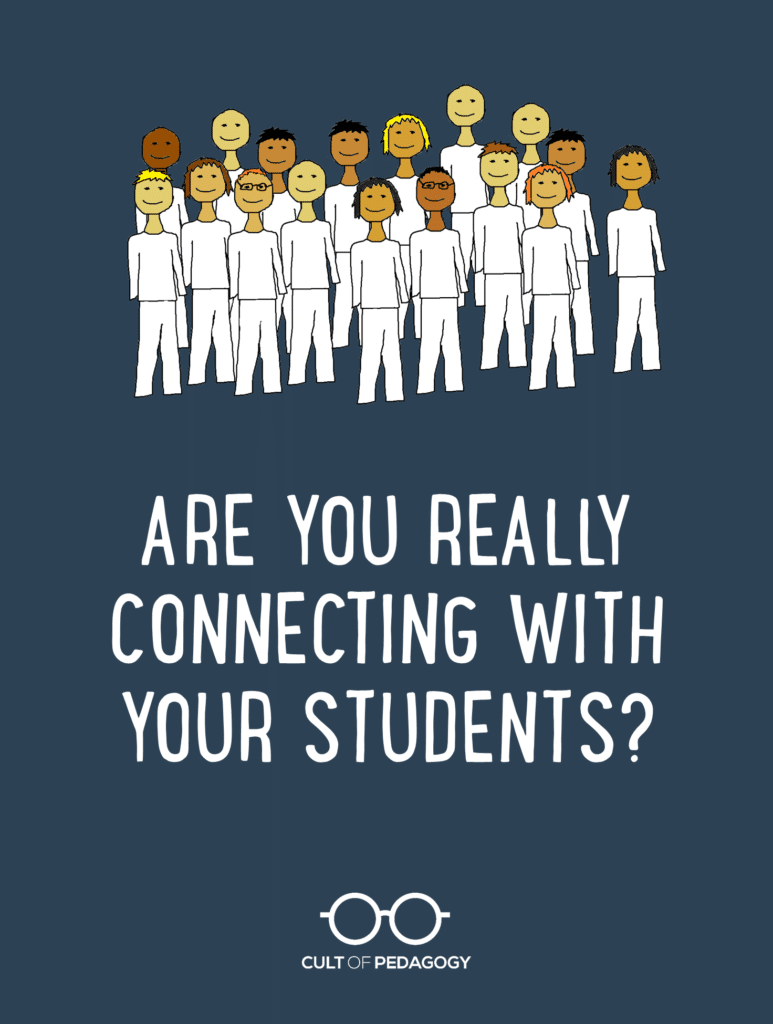Are You Really Connecting with Your Students?

Listen to my interview with Jim Sturtevant (transcript):
I’ll never forget what one of my college professors told me when I was studying to become a teacher. She said the number one factor in our effectiveness as teachers would be the relationships we built with our students. She felt so strongly about this that she paused, looked around so she could make eye contact with every person in the room, then repeated it: “More important than anything else you do as a teacher is the relationship you build with your students.”
I kind of didn’t believe her. I mean, I understood what she meant in theory, but I was pretty sure that planning interesting lessons and having a clear set of classroom guidelines were at least as important as “relationships.” I appeared to be listening attentively, but inside, I thought she was a little off the mark.
That was before I started teaching. Now I agree with her 100 percent. And even before I started reading James Sturtevant’s book, You’ve Gotta Connect — just skimming the table of contents — I knew I had found a kindred spirit, someone who believed the same as me and my college professor, that the relationships you build with your students are the key to working wonders in your classroom.

You’ve Gotta Connect: Building Relationships That Lead to Engaged Students, Productive Classrooms, and Higher Achievement
by James Sturtevant, 278 pages, Incentive Publications, March 2014
And the book definitely lived up to the promises made by that quick preview. You’ve Gotta Connect is full of practical, actionable advice and loaded with tools to strengthen the quality of your connection with students.
Keys to Connecting with Students
Although I recommend you read the whole book, here are a few take-away lessons from the book that can improve the way you connect with students right now:
1. Drop the nostalgia. One big barrier to connecting with students is our nostalgia for the past, the way we constantly compare our current students with the (better) ones we used to teach. “Do you remember earlier teaching years when parents were more involved and students were less hostile? Do you wish you were in that other school where you taught before — where you had fewer discipline problems and struggled with fewer slackers? Do you pine for last year when you got through all the material with students who behaved pretty well and seemed to enjoy learning? I don’t know any teacher who does not have bouts of nostalgia. But hear me now: you’ve gotta let go of it! This nostalgia interferes with connection to present students. It keeps you from seeing THESE students — their needs and gifts” (52).
2. Tell your own stories. When you share parts of your own personal life with students, they get more comfortable sharing their own, and this is how connections are made. “Try to tell some sort of a personal story about once a week. It doesn’t have to be long. It does not have to be earth shattering. When you get a lot of feedback or stories of their own, you know you have struck gold!” (202).
3. Learn their culture. Students live in a very different world than the one we lived in at their age. “You are, by definition, not ‘one of them.’ You don’t need to and should not be ‘one of them.’ If you want to connect to them, however, they must immediately sense that you value them” (81). Sturtevant urges us to learn about students’ musical tastes, the movies and T.V. shows they’re into, and the slang terms they use. “These actions show you care enough to pay attention to their world, even if it pulls you a bit out of your comfort zone to do so” (86).
4. Keep prying. Keep persisting. Be patient. With students who are slower to warm up, we need to put our egos aside and just keep trying. “Gentle, focused nudging of a reluctant student toward being comfortable enough to open up a bit” is what will ultimately get you there, but don’t rush it: “Be cool! You have time, perhaps all year. The goal is to have a strong relationship as soon as possible, but accept that it may not happen until late in the game” (88-89).
5. Run toward trouble. Connecting with students isn’t just about smiles and funny stories. “Troubled times are the best times for connection,” Sturtevant writes (226). “Be on the lookout for difficult times, blowups, setbacks, failures, hurt, and disappointments,” resolve problems in a constructive, respectful way, and your connection to those students will be stronger.
Helpful Tools for Personal or Group Study
You’ll get a lot of insight by reading You’ve Gotta Connect on your own, but it would also make an excellent book for group study. Sturtevant has included dozens of hands-on tools you can use to develop and examine your own practice, like the “Environment Stealth Check” worksheet, which asks you to sit in your teacher’s lounge and tally up the number of positive comments you hear about students versus the number of negative comments you hear, or the “Anatomy of a Conflict” worksheet, where you break down the components of past conflicts and get a clearer understanding of how you might have handled them better. These reproducible tools help you take the theories and ideas Sturtevant presents and apply them to your own teaching.
Listen to the Interview!
I also had the privilege of interviewing James Sturtevant for my podcast. In our conversation, he talks about how to deal with students who resist his attempts to connect, what it looks like when he has to reprimand a student, the research that shows the connection between teacher-student relationship and learning, and how people who aren’t naturally extroverted can still build strong relationships with their students.
You can listen to the interview using the player above. A full transcript is also available if you aren’t able to listen, but James is a pretty entertaining guy to listen to, so it’s worth the time if you can make it happen.
About the Author

James Sturtevant teaches social studies at Big Walnut High School in Sunbury, Ohio. You can find him at his website (his latest post is on reverse engineering your connection with students) or on Twitter at @jamessturtevant.
Join my mailing list and never miss another post. You’ll get weekly tips, tools, and inspiration — in quick, bite-sized packages — all geared toward making your teaching more effective and joyful. To thank you, I’ll send you a free copy of my new e-booklet, 20 Ways to Cut Your Grading Time in Half. I look forward to getting to know you better!